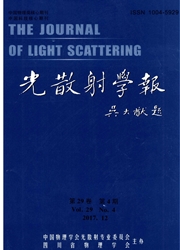

 中文摘要:
中文摘要:
运用等离子体发射光谱,分析衬底温度对氮化锌薄膜制备过程中各等离子体活性基团的影响,随着温度升高,N2^*第一正系B^3Πg→A^3Σ+u,N2^*第二正系C^3Πu→B^3Πg,N2+^*第一负系B^2Σ+u→X^2Σ+g,Zn*以及Zn+*活性基团等离子体发射光谱特征谱线强度逐渐增强;由于衬底温度升高,腔室中各离子动能增加,使得碰撞电离加剧,导致N2^*,N2+^*,Zn^*以及Zn^+*活性基团的等离子体离子密度增加;等离子体发射光谱分析结果表明衬底温度在一定范围内升高有利于氮化锌薄膜生长。采用离子源辅助磁控溅射技术在Al薄膜上制备Zn3N2薄膜;X射线衍射图谱(XRD)分析结果表明:室温下,反应生长出单一择优取向面(321)氮化锌薄膜;随着温度的升高,在Al膜上反应生长的氮化锌薄膜择优取向面逐渐丰富,出现(222),(400),(600),(411),(332),(431)以及(622)择优取向面,体现出随着衬底温度的升高,薄膜的结晶度逐渐增加。XP-1台阶仪分析的结果表明,随着衬底温度的升高,氮化锌薄膜的沉积率逐渐增大。场效应扫描电子显微镜(SEM)图表明氮化锌薄膜晶粒尺寸随着衬底温度的升高逐渐变小,表面结构更加致密,晶粒排列更加有序;SEM断面扫描显示Al膜和氮化锌薄膜结合非常紧密。衬底温度影响薄膜性能实验分析结果与等离子体发射光谱分析的结果基本一致,体现出等离子体发射光谱了解等离子体内在特性的有效、快捷性。
 英文摘要:
英文摘要:
The effects of substrate temperature on the plasma active species were investigated by plasma optical emission spectroscopy.With increasing substrate temperature,the characteristic spectroscopy intensity of the first positive series of N2^*(B^3Πg→A^3Σ+u),the second positive N2^*(C^3Πu →B^3Πg),the first negative series N2+^*(B^2Σ+u → X^2Σ+g)and Zn*are increased.Due to the substrate temperature,each ion kinetic energy is increased and the collision ionization intensified in the chamber.That leading to plasma ion density increase.These phenomenons' s show that the substrate temperature raises in a certain range was conducive to zinc nitride thin films growth.Zn3N2 thin films were prepared on Al films using ion sources-assisted magnetron sputtering deposition method.The degree of crystalline of the films was examined with X-ray diffraction(XRD).The results show that has a dominant peak located at 34.359°in room temperature,which was corresponding to the(321)plane of cubic anti-bixbyite zinc nitride structure(JCPDS Card No35-0762).When the substrate temperature was 100℃,in addition to the(321)reflection,more diffraction peaks appeared corresponding to the(222),(400)and(600)planes,which were located at31.756°,36.620°and 56.612°respectively.When the substrate temperature was 200℃,in addition to the(321),(222),(400)and(600)reflection,more new diffraction peaks also appeared corresponding to the(411),(332),(431)and(622)planes,which were located at 39.070,43.179°,47.004°and 62.561°respectively.These results show the film crystalline increased gradually with raise the substrate temperature.XP-1profilometer were used to analyze the thickness of the Zn3N2 films.The Zn3N2 films deposited on Al films in mixture gas plasma had a deposition rate of 2.0,2.2,and 2.7nm·min-1.These results indicate that the deposition rate was gradually enhanced as substrate temperature increased.Field emission scanning electron microscop
 同期刊论文项目
同期刊论文项目
 同项目期刊论文
同项目期刊论文
 A novel design approach of high temperature superconducting magnets by cultural evolution algorithms
A novel design approach of high temperature superconducting magnets by cultural evolution algorithms Low power test generation of digital circuits by using genetic simulated annealing for the reorderin
Low power test generation of digital circuits by using genetic simulated annealing for the reorderin Effects of nitrogen substitutional doping on the electrical properties of small radius (4,0) single-
Effects of nitrogen substitutional doping on the electrical properties of small radius (4,0) single- Minimization of binary decision diagrams by adaptive hierarchy genetic algorithm and its application
Minimization of binary decision diagrams by adaptive hierarchy genetic algorithm and its application Equivalence checking of combinational circuit using chaotic pattern simulation and binary decision d
Equivalence checking of combinational circuit using chaotic pattern simulation and binary decision d Verifying the equivalence of combinational circuits by test pattern generation based on structure fe
Verifying the equivalence of combinational circuits by test pattern generation based on structure fe Low power test pattern design for VLSI circuits using incorporate pseudorandom and deterministic app
Low power test pattern design for VLSI circuits using incorporate pseudorandom and deterministic app Test pattern generation with low power for delay faults in digital circuits by evolution method with
Test pattern generation with low power for delay faults in digital circuits by evolution method with 期刊信息
期刊信息
